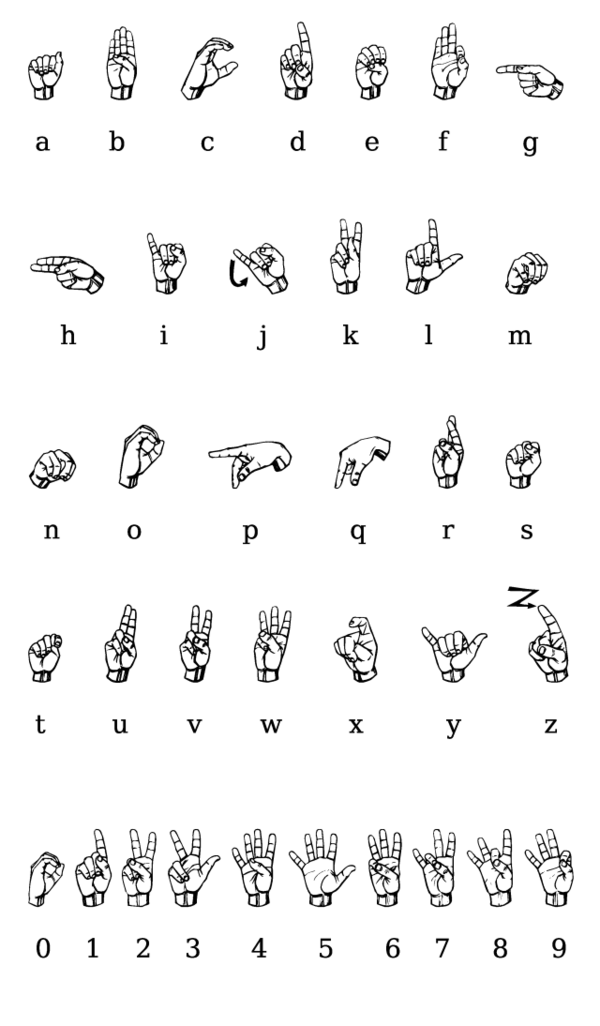AY Honors/Sign Language/Answer Key
The American Sign Language Alphabet is a manual alphabet that augments the vocabulary of American Sign Language when spelling individual letters of a word is the preferred or only option, such as with proper names or the titles of works. Letters should be signed with the dominant hand and in most cases, with palm facing the viewer.
Chart
The ASL alphabet is based on an old Spanish manual alphabet that dates back to at least the 17th century.
It is used with minor modification in Paraguay, the Philippines, Thailand, Malaysia, Hong Kong, Taiwan, and Singapore. The Asian countries just listed modify the T, for the ASL T is considered obscene. Instead, they use the T of the Irish manual alphabet, which is like an ASL X, but with the thumb tucked into the index finger (that is, the index finger wraps around the tip of the thumb). In Thailand, one indicates points on the left hand for the tone and vowel marks of the Thai alphabet, and aspiration is not indicated. The Paraguay alphabet is identical to ASL, except for the addition of the letter Ñ, which is an N swiveled at the wrist so that the fingers move side to side, and the letters LL and RR, which are L and R plus movement to the side.
It is also used in Germany, Austria, Norway, and Finland, again with a modification for the letter T. T is like G with the thumb placed atop the first knuckle of the index finger.
German Ä, Ö, Ü, and ß are signed like A, O, U, and S but with a downward motion, while SCH is a 5 hand (palm forward). In Norwegian and Finnish, the letters Ä, Å, Ö, Ø are derived by moving A and O (in the case of Å, in a small window-washing circular motion), and it is the Æ that gets the 5 hand (perhaps somewhat flexed).
[math]\displaystyle{ Insert formula here }[/math][math]\displaystyle{ Insert formula here }[/math][math]\displaystyle{ Insert formula here }[/math]== Good fingerspelling form ==
- The hand should either remain in place while fingerspelling, or more often, drift slightly away from the midline in the manner of text being written out in the air; although, this is a subtlemay find it helpful to hold the wrist of the hand doing the fingerspelling with the free hand so that they are forced to keep the hand from moving up and down while fingerspelling. Usually, only a few hours or days of this is enough to break the habit of unnecessary bouncing while fingerspelling.
[math]\displaystyle{ Insert formula here }[/math]
Common mistakes made by beginners
Many mistakes made by beginning fingerspellers are directly attributable to how the manual alphabet is most often shown in graphics.
Mistakes with letters
In most drawings or illustrations of the American Sign Language alphabet, some of the letters are depicted from the side to better illustrate the desired handshape even though, however in practice, the hand should not be turned to the side when producing the letter. The letters C and O are two that are often mistakenly turned to the side by beginners who become used to seeing them from the side in illustrations. Important exceptions to the rule that the palm should always be facing the viewer are the letters G and H. These two letters should be made, not with the palm facing the viewer or the speaker, but with the palm facing sideways - the hand in an ergonomically neutral position.
Mistakes with numbers
Another mistake made by people faithfully following the pictures in most illustrations of the ASL fingerspelling alphabet is the signing of the cardinal numbers 1 - 5 with the palm facing out. The cardinal numbers one, two, three, four, and five should be signed palm in (towards the signer). This is in contrast with the cardinal numbers six through nine which should be produced with the palm turned to face the person being addressed.
As with the letter O, the zero should not be turned to the side, but shown palm facing forward.
This applies only to the cardinal numbers however. Using numbers in other situations, such as with for showing the digits of the time for example, has different rules. When signing the time, the numbers are always facing the person being addressed, even the numbers one through five. Other signing situations involving numbers have their own norms that must be learnt on a case by case basis.
See also
External links
- ASL Fingerspelling Resource Site Free online fingerspelling lessons, quizzes, and activities.
- ASL Fingerspelling Online Practice Tool Test and improve your receptive fingerspelling skills using this free online resource.

